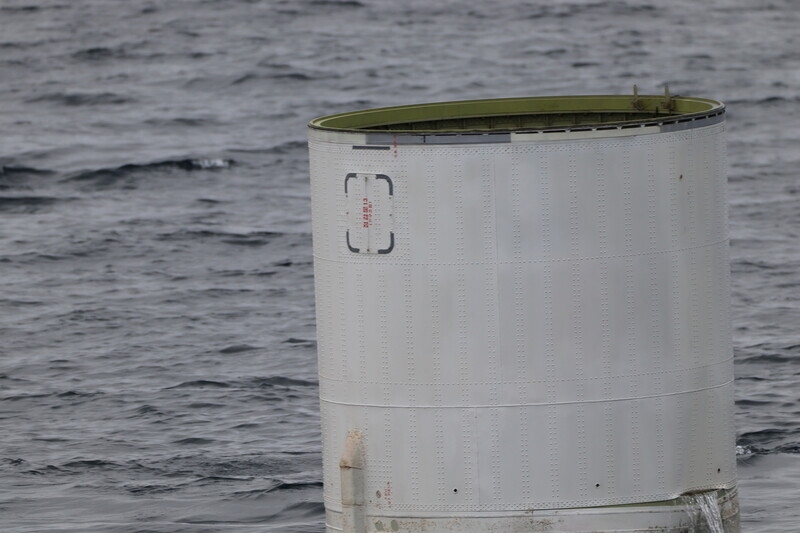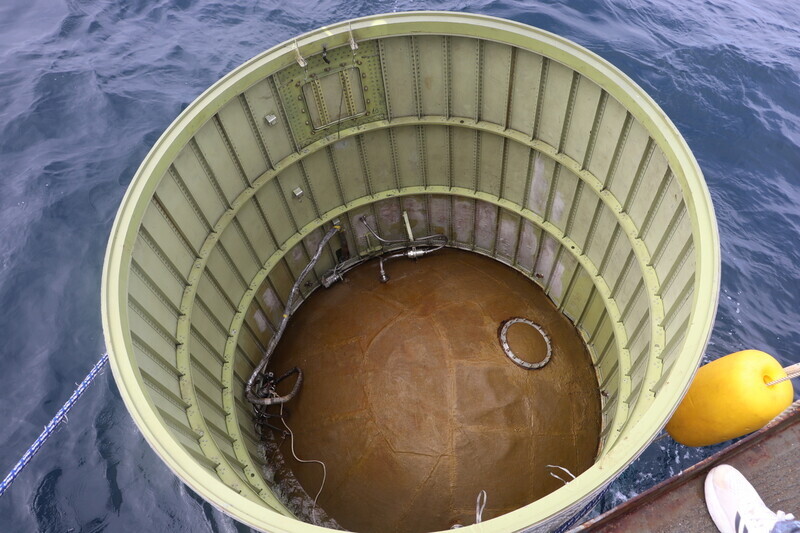hankyoreh
Links to other country sites 다른 나라 사이트 링크
Seoul intelligence believes course correction to be at fault for N. Korea’s failed satellite launch

The rocket carrying a military surveillance satellite launched by North Korea on Wednesday suffered a malfunction that caused it to fly abnormally and then crash into the West Sea, raising questions about the cause of the launch failure.
The failure came as a surprise since North Korea is thought to have achieved a considerable degree of technological expertise in rocket stage separation and guidance control while launching multiple intercontinental ballistic missiles and other kinds of launch vehicles.
While North Korea announced it would carry out another launch “as soon as possible,” experts say that preparing for a second launch may take a considerable amount of time.
North Korea was quick to acknowledge the failure of its satellite launch on Wednesday.
North Korea’s state-run Korean Central News Agency reported that the National Aerospace Development Administration “attributed the failure to the low reliability and stability of the new-type engine system applied to carrier rocket ‘Chollima-1’ and the unstable character of the fuel used” and that technicians have begun looking into the specific cause of the failure.
North Korea added that the launch vehicle “fell to the West Sea of Korea after losing thrust due to the abnormal starting of the second-stage engine.”
Ordinarily, the powerful thrust of the first stage propels the rocket to the second-stage separation point. After the first stage disengages, the second stage ignites, propelling the third stage (carrying the payload, in this case a satellite) outside of Earth’s atmosphere.
North Korea had notified the International Maritime Organization and the Japanese government that the first rocket stage would fall far out in the Yellow Sea west of Gunsan, North Jeolla Province. The point 200 kilometers west of Eocheong Island where the rocket actually crashed is on a similar latitude to Gunsan.
Given North Korea’s explanation and the location of the crash, Malligyong-1’s crash presumably resulted from losing momentum when the second rocket stage didn’t ignite properly following first stage separation because of the new engine system and fuel instability.
Prior to the rocket launch, the South Korean military had been less interested in the launch vehicle itself than in the performance of the satellite it was carrying and in the question of whether the satellite would be able to enter orbit and function normally. But despite those expectations, the reconnaissance satellite never had a chance to enter orbit because the second stage failed to separate, sending the rocket plunging into the ocean.
This was North Korea’s seventh satellite launch vehicle to be launched since August 1998, but only two of those launches (in December 2012 and February 2016) have managed to put satellites into orbit. (Neither satellite functioned normally, however.)
South Korea’s National Intelligence Service (NIS) believes that an awkward course correction was the cause of the launch failure.
Yoo Sang-bum, the ranking lawmaker of the People Power Party on the National Assembly’s Intelligence Committee, spoke to reporters following a plenary session of the committee on Wednesday afternoon.
“The NIS believes that a technical problem may have occurred during an attempted course correction that made a sharp turn from the west to the east. Malligyong-1’s flight path was different in that respect from previous rockets, in which both the first and second stages traveled in a straight line,” Yoo said.
The NIS also reported that Malligyong-1 was a small Earth observation satellite, measuring 1.3 meters in length and weighing 300 kilograms, that would only have been capable of elementary reconnaissance work with a maximum resolution of 1 meter per pixel.

The South Korean military, which has recovered the launch vehicle, is carrying out a comprehensive analysis as it seeks to locate where the problem occurred, either in the first or second stage.
The liquid fuel used in North Korea’s rockets is known for having a high degree of toxicity and pyroshock that makes them difficult to control. Ground tests should have been carried out prior to launch to determine the behavior of the new engine during high-elevation ignition and combustion, but that testing may have been inadequate.
Considering that North Korea promised to carry out another launch “as soon as possible,” South Korea’s presidential office believes a second launch of the military reconnaissance satellite could take place by the original deadline of midnight on June 10. Such a timeline would presume the cause of the malfunction was minor, however.
The NIS told the Intelligence Committee that it wouldn’t rule out the possibility of North Korea carrying a second launch soon at a different launch site.
But some analysts think it’s unlikely that another rocket launch will be held anytime soon.
“I think they’ll take their time with the next launch,” said a source in the South Korean military, who noted that after the failed launch of Kwangmyongsong-3 in April 2012, North Korea waited until December, eight months later, before carrying out a second launch. That source said the North Korean authorities are likely to proceed with caution since a second failure in a row could have consequences for the regime.
By Kwon Hyuk-chul, staff reporter; Kim Mi-na, staff reporter
Please direct questions or comments to [english@hani.co.kr]

Editorial・opinion
![[Editorial] Intensifying US-China rivalry means Seoul must address uncertainty with Beijing sooner than later [Editorial] Intensifying US-China rivalry means Seoul must address uncertainty with Beijing sooner than later](https://flexible.img.hani.co.kr/flexible/normal/500/300/imgdb/original/2024/0517/8117159322045222.jpg) [Editorial] Intensifying US-China rivalry means Seoul must address uncertainty with Beijing sooner than later
[Editorial] Intensifying US-China rivalry means Seoul must address uncertainty with Beijing sooner than later![[Column] When ‘fairness’ means hate and violence [Column] When ‘fairness’ means hate and violence](https://flexible.img.hani.co.kr/flexible/normal/500/300/imgdb/original/2024/0516/7417158465908824.jpg) [Column] When ‘fairness’ means hate and violence
[Column] When ‘fairness’ means hate and violence- [Editorial] Yoon must stop abusing authority to shield himself from investigation
- [Column] US troop withdrawal from Korea could be the Acheson Line all over
- [Column] How to win back readers who’ve turned to YouTube for news
- [Column] Welcome to the president’s pity party
- [Editorial] Korea must respond firmly to Japan’s attempt to usurp Line
- [Editorial] Transfers of prosecutors investigating Korea’s first lady send chilling message
- [Column] Will Seoul’s ties with Moscow really recover on their own?
- [Column] Samsung’s ‘lost decade’ and Lee Jae-yong’s mismatched chopsticks
Most viewed articles
- 1[Editorial] Transfers of prosecutors investigating Korea’s first lady send chilling message
- 2[Exclusive] Unearthed memo suggests Gwangju Uprising missing may have been cremated
- 3[Column] US troop withdrawal from Korea could be the Acheson Line all over
- 4[Editorial] Intensifying US-China rivalry means Seoul must address uncertainty with Beijing sooner t
- 5Xi, Putin ‘oppose acts of military intimidation’ against N. Korea by US in joint statement
- 6[Column] When ‘fairness’ means hate and violence
- 7China calls US tariffs ‘madness,’ warns of full-on trade conflict
- 8China, Russia put foot down on US moves in Asia, ratchet up solidarity with N. Korea
- 9‘Shot, stabbed, piled on a truck’: Mystery of missing dead at Gwangju Prison
- 10Records show how America stood back and watched as Gwangju was martyred for Korean democracy